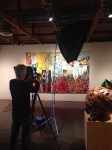If you’re fortunate enough to have today off for Indigenous People’s Day, I’ve got a suggestion for the best place to spend it: The Heard Museum in Phoenix, which has a series of events to commemorate the day.
Here is a list of the events, which begin at 12:30 p.m.
You may have heard that the Phoenix City Council voted that the city would celebrate Indigenous People’s Day. That makes it the largest U.S. city to celebrate the annual event.
As the news story reported:
The proposal to create Indigenous Peoples’ Day in Phoenix emerged in May, when residents Jeff Malkoon and Carlos Bravo submitted to the city an application for a historical commemoration.
“The city of Phoenix is built on what was the Hohokam civilization,” Malkoon told council members. “We just think this is a significant statement for a city like Phoenix, being such a center point in the Southwest.”
And this is part of a growing national trend, as CNN reports.
In what was a great preview of Monday’s Heard events, audience members at the Heard Sunday afternoon heard from two artists and two lawyers on the intersection of art, Indian identity and law. (I wrote about the event here.)
That gathering included insights from artists Matika Wilbur and Gregg Deal.
Deal’s film “The Last American Indian on Earth” was screened. It shows, in surprising and occasionally humorous ways, the complicated relationship mainstream American society has with Native culture.
Wearing a faux historic Indian costume (manufactured in China, for good measure), Deal strode about Washington DC. The reactions he got were troubling and laden with meaning.
As Deal says in the voiceover, “When you let the cameras roll, Americans, they don’t disappoint.”
As one hand-written sign he holds tells passersby, “My spirit animal is white guilt.”

L to R at the Heard Museum panel on Indian identity, art, and law, Oct. 9, 2016: Matika Wilbur, Kevin Gover, Gregg Deal, Brett Shelton.
Matika Wilbur then spoke, presenting her itinerant photo experience with Project 562, which aims to photograph citizens of each federally recognized tribe in the United States (there are now 566).
As she describes on her site:
“Most of the time, I’ve been invited to geographically remote reservations to take portraits and hear stories from a myriad of tribes, while at other times I’ve photographed members of the 70 percent of Native Americans living in urban settings. My hope is that when the project is complete, it will serve to educate the nation and shift the collective consciousness toward recognizing our own indigenous communities.”
A longtime educator from Seattle, Wilbur asked, “When are we going to stop asking our children to choose between cultural education and Western education?”
Wilbur also spoke about how Indian identity is “inextricably connected to the land.” Discussing the sensation known as solastalgia—separation from home—she wondered how the Cocopah, for instance, known as the people of the blue-green water, could be Cocopah if access to that water is denied or destroyed.
In the subsequent panel discussion, attorney Kevin Gover addressed that issue and the way violations have been visited on Native peoples by the American legal system. For example, in Fletcher v. Peck (1810), the U.S. Supreme Court determined that Indian title to land was not true title, as Indians were itinerant hunters and had never been farmers—an absolute misstatement of the facts. But it was decisions like that which provided the veneer of law to unjust decisions.
In fact, Gover pointed out, the most famous Native-land-title cases were collusive ones, manufactured conflicts presented by land speculators to prod a desired outcome from a compliant Court. To America’s enduring shame, the Court proved a willing co-conspirator in the effort.
The American legal system, Gover said, “played a huge role in the removal and dispossession of Native peoples.”
Through their art, Matika Wilbur and Gregg Deal explore America’s complicated relationship with Native peoples. As a teacher, Wilbur reminded the audience that these mainstream viewpoints are learned ones, and that the dominant Western view of Indians helps shield society from honest appraisals.
To illustrate that, she showed search results in Google images from searches for the simple terms “African American,” “Asian American,” “Hispanic American,” and, finally, “Native American.”
Among all of those searches, the Native American search was the only one that yielded an almost uniform view of Indians as historic beings—and actually as faux historic beings. Nearly every image reconfirms the popular image of Indians as conceptualized 150 years ago.
Where are the modern Indians who live among us, Wilbur asked.
They are all about us, Wilbur and Deal said. If people are willing to see.
Again, here are today’s Heard Museum events.
Follow @azatty












































